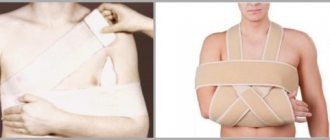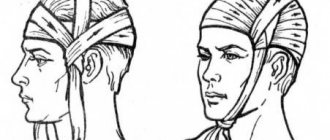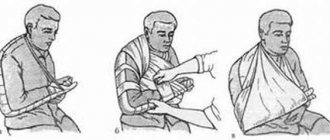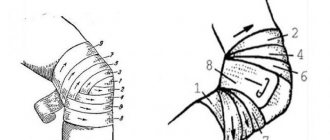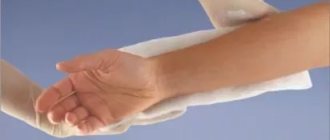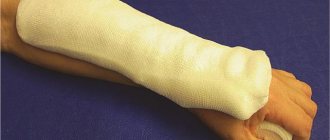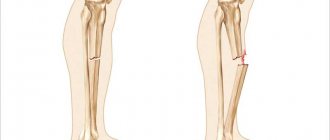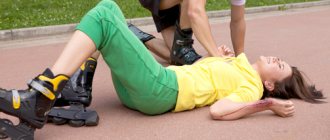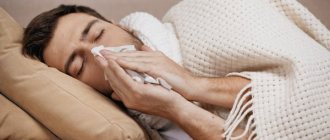A spica bandage is a type of cross-shaped or figure-of-eight bandage. Its advantage is the ability to provide reliable fixation in areas of the body of complex shape, in the area of various joints - hip, shoulder, wrist and others. The application technique is simple, anyone can master it in order to be able to provide first aid to victims of various injuries.
Author of the article / Site experts Shulepin Ivan Vladimirovich, traumatologist-orthopedist, highest qualification category
Total work experience over 25 years. In 1994 he graduated from the Moscow Institute of Medical and Social Rehabilitation, in 1997 he completed a residency in the specialty “Traumatology and Orthopedics” at the Central Research Institute of Traumatology and Orthopedics named after. N.N. Prifova.
Classification of dressings
Dressings are classified according to several parameters. According to the purpose of use, the following types of medical dressings are distinguished:
- holding;
- pressing;
- immobilizing;
- occlusive - to seal the wound from exposure to water and air;
- aseptic;
- medicinal - for supplying medicinal substances to the damaged surface;
- corrective - to correct deformities.
Types of dressings vary depending on the material used:
- soft;
- hardening (gypsum and starch);
- hard (tires).
Rules for wearing a Deso bandage
How to choose and wear correctly?
A ready-made Deso-type bandage on the shoulder joint is worn over underwear according to the principle of a T-shirt. The affected arm is bent at a right angle, the forearm parallel to the floor. Above the elbow, the product is attached to the body horizontally using a belt. The device should not dangle or squeeze.
The appropriate size is selected by a traumatologist or orthopedic surgeon. He puts the bandage on the patient for the first time and teaches the necessary technique.
How much to wear and how to sleep?
The duration of wearing the Deso bandage depends on the nature of the injuries. When a shoulder is dislocated, it is worn from a week to a month. Younger and more active patients require longer immobilization to prevent secondary injuries. For uncomplicated closed fractures of the shoulder or collarbone, the product is worn for about a month.
How much to wear during the day and whether it can be removed at night, the doctor indicates. When worn around the clock, the most common option is to sleep on your back.
Basic rules for applying bandages
The ability to apply a simple bandage can be useful to everyone, so you should know the basic rules and techniques used when applying different types of bandages:
- do not touch the wound with your hands;
- use sterile dressing material;
- carry out the dressing facing the victim in order to understand whether the manipulation does not cause unnecessary pain;
- bandage from bottom to top and from the periphery to the center;
- roll out the bandage without removing it from the body;
- bandage the limb in a position comfortable for the victim: legs straight, arms slightly bent.
In this case, the bandage should be moderately tight so that it does not interfere with normal blood circulation and does not move out.
Types of fixation
A spica bandage is applied using a regular gauze or elastic bandage. The first type of fixation is suitable for dressing wounds - holding sterile material. An elastic bandage is convenient for immobilization for various joint injuries and diseases; it is quite reliable, puts less pressure on tissues and does not interfere with blood circulation. For wounds, this type of fixation is not recommended, because the elastic bandage makes it difficult for air to reach the wound, which can create increased humidity and suppuration.
The bandage is applicable on a wide variety of areas of the body: in the area of various joints, in the groin and buttock areas, forearm, thumb and other areas of the body that are inconvenient for conventional bandaging.
Application techniques depending on the type of dressing used and the place of its application
The technique of applying bandages for different parts of the body is different and depends on what type of medical bandage is used.
For head injuries
What bandage is used to provide first aid for a head injury? There are several varieties:
- the frenulum is applied to the parietal and occipital parts;
- the cap and cap of Hippocrates cover the entire scalp;
- a figure-of-eight monocular or binocular bandage is used for eye injuries;
- A sling bandage is used for injuries to the facial part of the head.
For limb injuries
When applying bandages to limbs, it is especially important to adhere to the rule of bandaging in the direction from bottom to top. This technique will prevent the accumulation of venous blood in the unligated parts of the limb.
A reliable spica bandage is used to bandage the shoulder and hip joints. A figure-eight bandage is applied to the elbow and knee joints. The lower leg, shoulder, forearm and thigh are bandaged in a spiral or spicate manner.
Which bandage is used depends on the degree of load.
Pressure bandage and tourniquet
A pressure bandage is used for minor bleeding of a capillary or venous nature, as well as for violation of the integrity of small arteries. It can be left on the body until the victim is admitted to a medical facility.
A tourniquet is used for bleeding from large arteries. It should not remain on the body for more than 1 hour in the cold season and more than 2 hours in the warm months.
Immobilization splint
When applying an immobilizing splint bandage to the limbs, you should adhere to the basic rule - grab the joints above and below the injury site, except in cases of hip and shoulder fractures, when the entire limb is fixed at three points.
In areas of bony protrusions, the splint is lined with soft material to prevent the formation of bedsores and abrasions.
Indications for use
The indications for the use of spica bandages are quite broad; they are divided into 2 groups:
- Fixation of protective aseptic material:
- for various wounds;
- for burns;
- for applying a compress to the joint.
- Immobilization of a joint or limb in case of injury:
- bruises;
- sprains;
- dislocations;
- fractures.
This type of fixation is also used for acute inflammation of the joints, exacerbation of chronic arthrosis, and arthritis with severe pain.
Compression bandages
They are widely used for diseases of the veins of the lower extremities. When applying such a bandage, it is important to follow the rule of gradually reducing the degree of compression from the foot to the knee. There should be no numbness in your fingers. The patient should feel the effect of a tight-fitting boot.
The self-fixing medium-stretch ones - PÜTTERBINDE® (“Pütterbint”) and the long-stretch Lastodur® straff (“Lastodur tight”) from HARTMANN are very convenient to use. They vary in size and degree of elasticity.
Preparation for the procedure
First of all, you need to give the patient a position that will be comfortable both for him and for the one who will bandage. If the bandage is applied to the area of the shoulder and shoulder joint, the patient is seated so that he relaxes, and when applied to the hip joint or lower limb, the patient must be laid down.
You need to prepare materials: wide (20 cm) gauze or elastic bandage, fastening pins, adhesive tape (plaster), sterile wound wipes, cotton-gauze roller.
Occlusive dressings
They have unique properties: they accelerate the process of epithelization of wounds, improve tissue granulation even in the case of chronic ulcers, and protect the skin from environmental influences. They have found their use in military field surgery for penetrating lung wounds, as well as in dermatology, where they are used to enhance the effect of medicinal drugs.
If you need help choosing, our specialists will advise you online or by phone and tell you the name of the bandage you are looking for.
Shoulder bandaging technique
In most cases, a spica bandage is used in the area of the shoulder joint, where injuries and diseases are most common. There are 2 methods of overlay: ascending and descending.
Ascending spica bandage
The algorithm for applying an ascending bandage is as follows:
- The patient is seated facing the bandage, with his arms down. Around the shoulder, make 2 securing initial rounds in a clockwise direction.
- They move to the back, and through the opposite armpit they exit to the anterior surface of the chest.
- The bandage is led to the front surface of the shoulder, crosses the initial rounds, circles around the shoulder and again leads to the back, overlapping the previous round by ½-2/3 of the width.
- The bandage is again passed through the armpit to the chest, but this round is placed ½-2/3 higher.
- They go around the shoulder again at a level higher, go back, and everything is repeated, with each move of the bandage being located higher than the previous one. The last turn is wrapped around the shoulder and the bandage is secured with a pin.
The result is a fairly reliable fixation, and on the outside of the shoulder, the placement of crossed rounds resembles an inverted ear.
Descending spica bandage
It is applied according to the same principle as an ascending bandage. The difference is that the first 2 rounds are secured not on the shoulder, but around the chest, then they move high to the shoulder, go around it, and bring the bandage to the back, armpit and chest. Everything is repeated, only each subsequent round moves not up, but down. A “spike” also forms on the outer surface of the shoulder, only turned in the opposite direction – upward. The technology is presented in the video:
Characteristics of lower extremity injuries
A bruise, accompanied by swelling, bruising and pain, is considered the most gentle of all types of injuries to the lower extremities. It can occur after a fall or sharp blow. In this case, the integrity of the blood vessels in the skin is disrupted, a bruise appears, which changes its color over time. In addition, soft tissue bruises can accompany more dangerous injuries - fractures, ruptures.
Joint dislocation is a pathological condition in which parts of the joint, most often the articular head, leave their usual “location”, for example, the head extends beyond the acetabulum.
Such injuries occur due to the fact that a person makes a sudden and atypical movement that goes beyond the functional capabilities of the joint, as well as due to impacts and lifting heavy objects.
A bone fracture is the appearance of a crack or break in it, which may be accompanied by the distribution of bone fragments in the wound. Fractures can be closed or open - in the first case, the skin remains intact, and in the second, the skin is chopped or cut by protruding bone fragments or as a result of mechanical force. The person feels severe pain, the fracture site swells, and blood circulation is impaired. It becomes extremely difficult to move and step on the sore leg due to pain.
Tears and sprains of tissues, ligaments, and muscles occur due to sudden forced movements that exceed the ability of the joint to withstand loads. Athletes often encounter such injuries, but ordinary people are not immune from painful and dangerous injuries. It is especially facilitated by excessive overload, exercise in the gym without following the rules of exercise and safety precautions.
Tissue crushing occurs as a result of a strong blow - as a result, their normal structure and vitality, blood circulation and metabolic processes are disrupted. Such wounds are dangerous with a high probability of developing infection and inflammation; they take a long time and heal poorly.
The meniscus is a structural element of the articular apparatus, which serves to stabilize its component parts. The most common causes of a meniscus tear are sports activities. However, not only athletes can encounter it - older people with arthrosis also often experience rupture of this articular element. This condition is dangerous for humans, as it causes inflammation, fever, joint blockade, severe pain, and decreased mobility.
How to care for your bandage
The dressing must be changed by a healthcare worker.
The spica bandage can be used for 3-12 weeks. The duration of wearing is influenced by the degree of complexity of the injury or the stage of chronic joint disease. The age of the patient, the rate of regeneration, and the presence of a history of cardiovascular pathologies are important.
The dressing is changed a week after application. When changing bandages, the doctor assesses the condition of the wounds and treats them with antiseptic and anti-inflammatory agents. If the skin is damaged, the dressing material should not be torn off if it is stuck. You need to soak the bandage with hydrogen peroxide.
The bandage may be removed earlier if the following negative symptoms appear:
- severe itching under the dressing;
- the appearance of a sharp putrid odor;
- constant or periodic pain in the shoulder system when moving or at rest;
- the appearance of swelling, redness of the skin below or above the border of the bandages.
A spica bandage cannot be worn for a long time if metabolic processes are disrupted. People with diabetes may experience dermatological problems.
Shoulder brace with strong fixation
The orthosis has additional straps, with the help of which a strong fixation orthosis can be created from a medium-strength bandage. Its material is porous, allowing the skin to breathe. When the patient uses ointments and creams, the heat-saving effect will enhance the effect of their use.
Benefits and indications:
◉ After fractures of the proximal humerus
◉ When playing sports
A frank interview with a German rheumatologist after working in Russia for Russia Today
Dr. Klaus Maier
Head of the Department of Joint Surgery at the Clinic for Traumatology, Orthopedics and Sports Medicine Bonn
Read the interview
“Russian medicine is a mystery to me. They treat joints for years instead of 3 weeks and reject new effective remedies!” Click the “Read interview” button
◉ Muscle damage
◉ Muscle pain
◉ Vibrating production loads
◉ Recovery after surgery
◉ In complex treatment with massage and exercise therapy
In China, they don’t know what back or joint pain is, and they don’t see a doctor until they’re 80 years old!
Konstantin Kovalev
Read more…
Good afternoon My name is Konstantin Kovalev, I have been treating diseases of the musculoskeletal system in Russia for more than 30 years. Imagine my surprise when I learned about the unique development of our scientists... at a conference in Shanghai!
◉ Inflammatory diseases
◉ Arthrosis, arthritis
◉ Static constant loads on the shoulder
◉ Periarthritis
The size is selected according to the circumference of the shoulder. Adjustable to fit using straps.
Basic functions of a medical device
The joint is characterized by constant intense loads as a result of movement of the upper limb. If the functional activity of the arm decreases, the shoulder joint is examined. Wearing a bandage is recommended by traumatologists for immobilization and stress reduction, for example, during active sports. It provides moderate fixation, that is, it simultaneously stabilizes the joint and relieves its ligamentous-muscular system. The orthosis performs the following functions:
- supports the joint and arm, accelerating the regeneration of damaged tissues;
- prevents excessive joint mobility, which can provoke further injury;
- prevents the occurrence of discomfort when moving your hand, turning or bending.
Wearing fixing devices limits the dynamics of the striated muscles, which has a positive effect on the condition of the ligaments. They are significantly injured when dislocated, especially the abdominal end of the clavicle. To restore them, complete immobility is necessary, otherwise relapses of the pathology occur, accompanied by severe pain in the shoulder joint. An orthosis is often used to simultaneously fix the arm and shoulder, since if injured, any movements of the upper limb can slow down recovery. If necessary, medical devices are used to completely immobilize the entire thoracic spine.
Designs made of breathable materials are prescribed to patients who have rapidly progressing degenerative changes in the articular structures. In addition to taking NSAIDs, glucocorticoids, and chondroprotectors, weak fixation of the joint is required. This method of conservative treatment does not allow destruction to neutralize the positive effect of pharmacological drugs.
The bandage was first mentioned as a separate medical device in manuscripts dating back to 1700 BC. The famous laws of King Hammurabi of Babylon describe the procedure for wearing a fixation device to prevent the protrusion of an inguinal hernia.
Signs and types of chest injuries
Content:
- Signs and types of chest injuries
- Why are bandages needed for chest injuries?
- Rules for applying bandages for chest injuries
- Types of bandages and dressings for the chest
The main classification of such lesions is their division into penetrating and non-penetrating wounds. Penetrating refers to injuries that affect the integrity of the pleura, while the internal tissues of the lungs and other organs in the chest may not be damaged. Chest wounds can also be through, tangential or blind. Through injuries are characterized by the presence of two openings - an entrance and an exit, through which a wounding object penetrates into the body and then exits. Tangential wounds pass close to bones or organs without affecting them. Blind wounds are a lesion in which the wounding object or part of it (bullet, fragments) remains in the wound.
Detection and differentiation of chest wounds are not difficult, especially if they are open: wounds are characterized by pain, deterioration of respiratory function, limited mobility, swelling, bleeding and damage to the skin (open injuries). Bleeding can be venous, arterial or parenchymal, while the first two are extremely dangerous for humans, as they can very quickly cause large blood loss and death of the affected person. Serous-bloody contents may also be discharged from the wound.
The most dangerous is considered to be a wound to the subclavian artery - with a wide wound, fatal bleeding occurs within a few minutes. If there is a blind or through wound, this is complicated by the formation of a pulsating hematoma, which can threaten a person’s life for a long time.
Non-penetrating types of wounds can be accompanied by extensive destruction of muscles and ligaments, as well as bone structures.
Requirements for manipulation and necessary materials
Before applying the bandage, sit the victim down and calm him down. The doctor or nurse should talk about the upcoming process. Before bandaging begins, you need to help the person remove his clothes.
Before applying the dressing, a roller is placed in the armpit to support the arm. The wound is treated with antiseptics and covered with sterile cotton wool or a gauze bandage.
To apply a bandage, you will need 2 bandages with a width of at least 14 cm, sterile cotton wool and gauze pads, and a safety pin.
